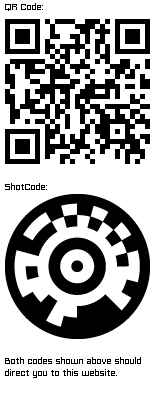Mobile Phone Codes
 Saturday, January 27, 2007 at 12:38AM
Saturday, January 27, 2007 at 12:38AM 
Will our gadgets ever catch up with the Japanese? Well, not likely, but hopefully 2007 will be the year that the US gets mobile codes. In Japan, most camera-phones are already equipped with mobile code reading software. It is becoming popular in Europe as well. To read the codes, you must have the right software installed on your phone. Point your camera and it will read the code. This can contain a phone number, a link to a website, or some other piece of data, and allows the user to act on it at that moment or store it for later use.
See a poster for a concert you want to see? Target the code, and purchase a ticket right from your mobile phone, with a click. See a product on the shelf and want more detailed information or the specs and warranty? Pull out your phone and click. Want to know the nutritional ingredients in your fast food meal? Want to buy the shirt worn on that billboard?
Two competing standards in this market are QR Code (top left), and ShotCode (bottom).
Besides square vs round, the major difference in the two is that ShotCode’s technology is proprietary while QR Code is an open standard. QR Code is also more widely used internationally, and has been around longer. It was originally developed to track auto-parts, and it was approved as an international standard in June 2000. Knowing the outcome of Sony’s Betamax vs JVC’s VHS battle, my money is on QR Code.
QR Code was developed by the Japanese company, Denso-Wave. A Swedish company named Kaywa has developed a camera phone reader plaform on the QR Code standard.
Go here to download software for your camera-phone to read QR Codes.
Go here to make a custom QR Code that you can download, print, etc.
ShotCode was developed by the Swedish company, OP3.
Go here to download software for your camera-phone to read ShotCodes.
Go here to make a custom ShotCode that you can download, print, etc.
(Before making a ShotCode, you must give contact info, then they send you a password via email.)
As I’ve seen QR Codes getting coverage recently in the trade press, it reminded me of a conversation I had a couple of years ago with business acquaintances from R/GA. They were involved in some kind of test market with their Target client. As it was explained to me, the shopper would be able to use their camera phone to read a bar code on the edge of the isle’s shelf, and get additional information- reviews, specs, warranty, etc. about the product downloaded to their phone. I never heard anything else about the Target project.
Even then, it seemed like deja’vu. Back in 2001 I attended a presentation, while working on the Intel account at MVBMS/EURO. One of our media planners had a vendor in that was peddling a technology that would read barcodes from print ads. They gave us all a free CueCat barcode reader. I was very skeptical of the implementation, and asked the presenter why anyone would install software, connect a piece of hardware, drag their magazine over to their computer, then use the barcode reader, just to pull up a website. Wasn’t typing in a URL a fairly easy task? The answer they gave was that this was just a stop-gap solution in order to be first to market, and that they were developing a version of the reader that would work in camera phones– As soon as camera phones became common place (this was in 2001), then there would be no need for the barcode reader. The CueCat flopped and became a bit of a joke from the dot-com crash, but their vision may have just been ahead of its time. By 2002, DigitalConvergence, the company behind the CueCat, had gone out of business. When unpacking my boxes from my move last year, I threw away my CueCat.
Maybe 2007 will finally be the year.

Reader Comments